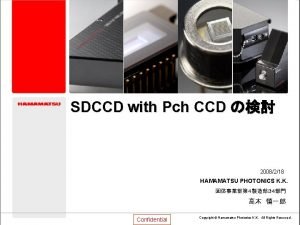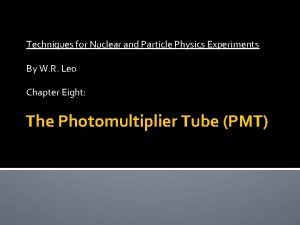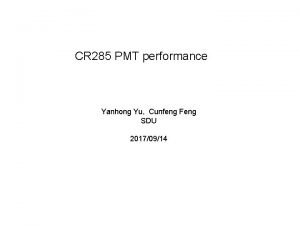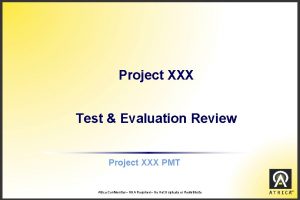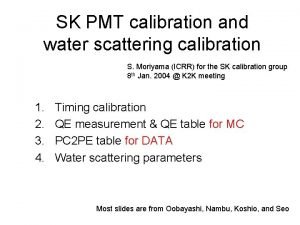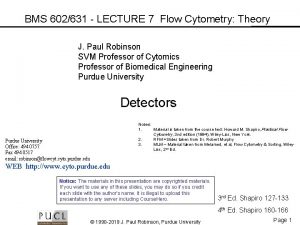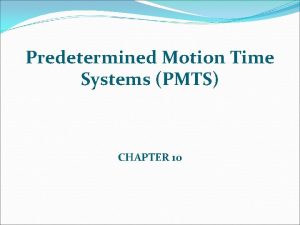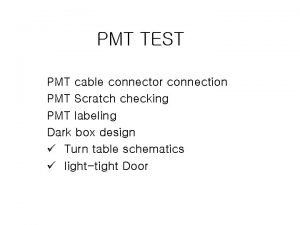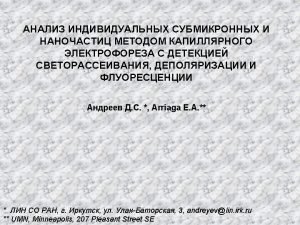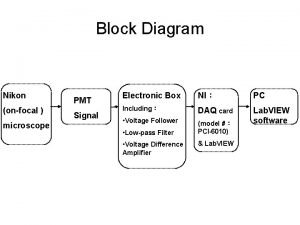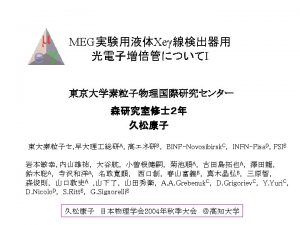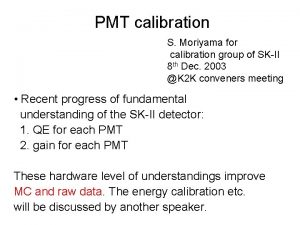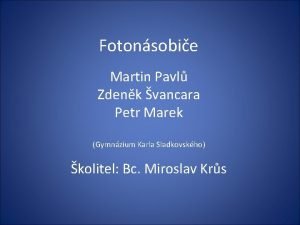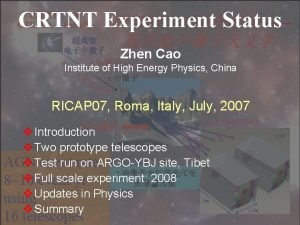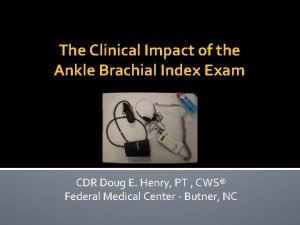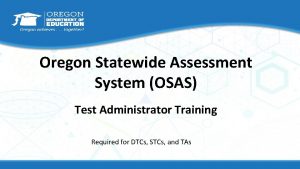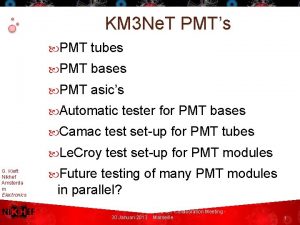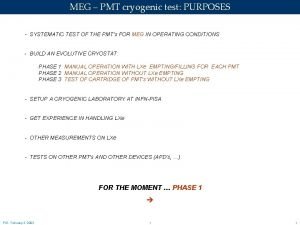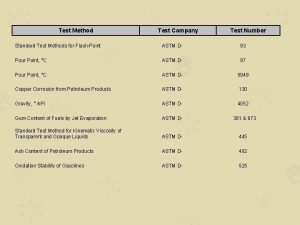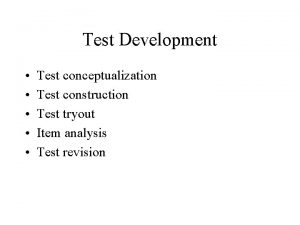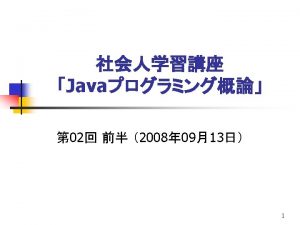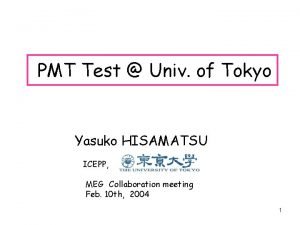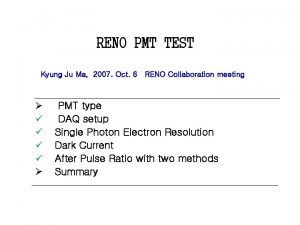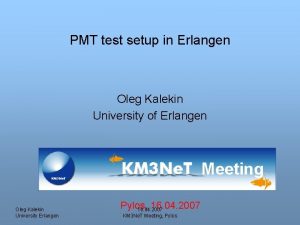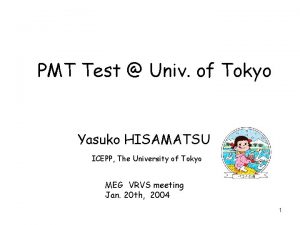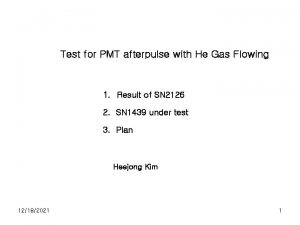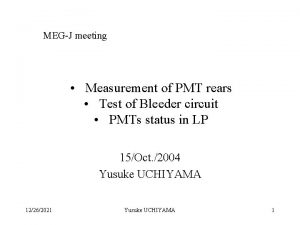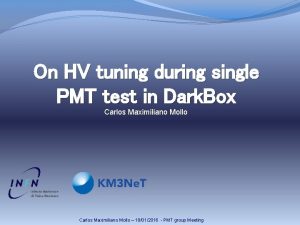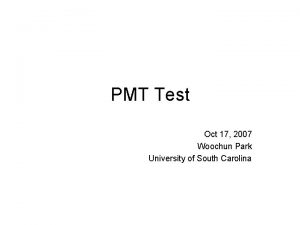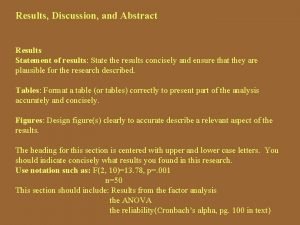PMT Test Results Gary Smith gary smithed ac





































- Slides: 37

PMT Test Results Gary Smith gary. smith@ed. ac. uk Watchman Collaboration Meeting PMT Working Group 10 th January 2019 08: 00 HST (18: 00 GMT)

CONTENTS OPERATIONS Timeline Test Rig Procedure RESULTS Gain Calibration Gain Consistency Peak To Valley Dark Rate Afterpulsing Liz Kneale Leon Pickard Matt Needham Steve Quillin and Tom Shaw Anthony Ezeribe CONCLUSIONS Next Stage Summary 2

OPERATIONS

Timeline July – Aug Set up test stand in Edinburgh and Sheffield Aug - Sept – Oct Installation and commissioning at Boulby Initial testing and refinement of procedure Oct 12 th First official tests begin – run one Nov 15 th Both tents operational – eight PMTs per day max. Nov 22 nd once Thanksgiving - all 101 PMTs tested at least Nov – Dec Underground testing of eight PMT sample Tested PMTs Google Sheets 4

Boulby Shifts Breakdown Institute AWE Davis Edinburgh Livermore Liverpool Sheffield # Shifts 35 15 39 9 10 49 A BIG thank you to all shift takers! 5

Boulby Test Rig R 7081 10 inch PMT PS 776 10 x Amp. CAEN V 1730 B 2 ns sampling (0. 5 GHz) Up to 20 us readout Edinburgh LED driver Phillips PM 5786 B Pulse Generator ~10 k. Hz Ortec 416 A Gate generator 6

Boulby Test Rig PMT positions Square mirror /attenuator Single optical fiber under central ND filter Four PMTs Tent B PMT positions Custom mechanical support structure (1/2) The mechanical structures were located inside mobile photographers dark tents within a dedicated lab room. Image above shows Tent A (B) at back left (front right). 7

Data Taking Procedure Afternoon Load next set of PMTs and ramp to nominal HV Other tasks: PMT cable crimping, software development, … Next morning Testing begins - follow operating instructions guide Main data taking steps shown in table below Test Events (M) Time (min) Gate (ns) Volume (G) 1 Nominal HV 3. 0 5 220 0. 7 2 Gain – 5 HV steps 3. 0 x 5 25 220 3. 5 3 Operating HV 3. 0 5 220 0. 7 4 Afterpulsing 0. 5 15 10200 3. 0 • 5 Periodic checks (data e-log entries Dark Rate 9. 0 volume, 15 charge spectra) 220 and 2. 1 • Meta-data recorded in Tested PMTs Google sheets: o PMT serial numbers, HV current, ambient temp, … • Operations meeting conference call held daily

Common Software Tools Fixed window charge histograms Gain Calibration Peak to Valley Full Spectrum Fit Peak to valley fitting routine baseline signal late and/or afterpulsin g Calibrated waveforms sample showing example fixed windows Peak to valley results Gain calibration and consistency results In progress Full fit working and ready to utilise Common analysis framework skeleton on Github Full fit to charge spectrum example 9 npe = 0. 2

RESULTS

PMT gain analysis Gain Calibration Liz Kneale

Gain Calibration Procedure Record SPE spectrum at 5 HV settings 100 V intervals around operating voltage Find SPE peak - three methods studied 1. Maxima in fixed ranges above pedestal 2. TSpectrum – use second peak 3. TSpectrum then Gaussian from peak to valley fit Power law fit example Determine HV for 107 Gain Fit TGraph with power law Gain calculated relative to the charge of the electron R = 50 Ohms, electronics gain = 10 / 2 = 5 12

Gain Calibration Results Good agreement with Hamamatsu shipping data Some workarounds required to include all data due to • • • spectra with more than two peaks TSpectrum finding fake peaks No clear peak for some low HV steps Areas which can developed further are understood 13

Gain Consistency Leon Pickard UC Davis

Shipping Underground Eight PMTs were transported in two sealed skips (temporary PMT shipping solution) Other equipment was transported in a third open skip Timeline Testing location. Furthest away from possible light sources (e. g. communal room) November 22 nd, (23 rd) surface testing - batch one (two) 26 th shipped underground in afternoon 27 th arrived underground in morning 29 th, (30 th) underground testing – batch one (two) December 4 th shipped to surface 6 th, (7 th) surface testing = batch one (two) 15

Surface & Underground Conditions Surface Underground 20 – 24 23 – 24 Light exposure PMT testing room in darkness. Lab in darkness overnight. Testing carried out remotely (dark rate test done locally) Time of tests 9 am – 5 pm 5 am – 10 am Average Magnetic field (μT) 45 49 Vertical / Horizontal field (μT) 42 / 16 45 / 19 Cosmics rate 2 × 10− 2 cm− 2 s− 1 4 × 10− 8 cm− 2 s− 1 Temp. range (°C) 16

Gain Calibration Repeatability Operational Voltage (V) • Measured operating voltages consistent over runs (HV for Gain 107) • The largest range only 9 V (PMT #171) • No discrepancy observed between the underground (UG) and the surface runs. • The fit uncertainties were also consistent over all run periods – all below 1 V Operating voltages consistent under repeat testing! Test 17

Peak to Valley Matthew Needham 18

Procedure TSpectrum to identify pedestal and SPE peak Gaussian fit around SPE using TSpectrum result repeat fitting with range adjusted to maximum Parabola fit to valley using TSpectrum result repeat fitting with range adjusted to found minima Gaussian fit Parabola fit Peak to valley calculated from fit parameters Charge histograms with window around peak gave slightly larger ratio (~ 0. 2) Peak to valley uncertainty from fit ~0. 01 Results reproducible at 0. 01 -0. 02 level 19

Results Our results are clearly correlated with those from Hamamatsu Most tubes measuring slightly smaller peak-to-valley Peak-to-valley mostly above 2 though Double Chooz report higher ratios when using u-metal shield [ C. Bauer et al. 2011]

Results Data divided according to position in Rig A Position 0 Position 1 Bad Position 2 Could differences lower ratios be down to position in the rig ? Good Related to noise? Position 3 Bad Good 21

Results Data divided according to position in Rig B Position 4 Position 5 Bad Position 6 Twenty PMTs were tested in the second rig (tent B) during run one Good 80 were tested in rig A Position 7 Bad Good 22

Visible differences PMT 42 in location 3 PMT 32 in location 6 Do results hint at noise or illumination playing a role ? 23

Surface and Underground PMT ID Surface test 1 Underground Surface test 2 130 3. 9 4. 4 3. 8 131 2. 5 3. 2 2. 4 132 2. 2 3. 1 2. 3 133 3. 0 3. 3 90 2. 9 3. 6 2. 8 159 2. 4 3. 2 2. 3 166 2. 5 3. 4 2. 5 171 3. 5 3. 6 PMTs appear to perform better underground Could this be due to a less noisy environment? 24

Peak To Valley Summary • Fits were successful for all PMT data • Surface results are similar before and after transit • Higher ratios for underground results not prescribed to underground specific conditions • Good comparison to Hamamatsu shipping data found for certain rig positions • Further investigations into consistency of grounding, illumination and background noise required 25

Dark Rate Steve Quillin Tom Shaw 26

Dark Rate Count events above SPE threshold 1. Fixed: ADC = 630 2. Calculated: Ped+(SPE-Ped)/2 3. Manually determined • The fixed threshold method is comparable to Double Chooz (10 m. V threshold) • Baseline noise and offsets motivated studying a second method clean spectrum (PMT 84) Example of pulse peak histogram (peak of voltage pulse in arbitrary units) 27

Dark Rate Count events above SPE threshold 1. Fixed: ADC = 630 2. Calculated: Ped+(SPE-Ped)/2 3. Manually determined • The fixed threshold method is comparable to Double Chooz (10 m. V threshold) • Baseline noise and offsets motivated studying a second method • A third manual threshold method was used to allow outliers to be included noisy spectrum (PMT 1) Example of pulse peak histogram (peak of voltage pulse in arbitrary units) 28

Dark Rate Tested vs Hamamatsu dark rate using manual threshold method mean std dev Shipping Data 3044 1763 Manual Threshold 2489 1172 Double Chooz 2200 500 29

Dark Rate Comparison of dark rates for surface and underground testing The fixed threshold method used for these results Need to investigate noise and baseline underground Run ID 30

Afterpulsing Anthony C. Ezeribe 31

Types of Afterpulsing Two categories of Afterpulsing 1. photoelectron in-elastically scatters off PMT dynode - afterpulse arrives up to 80 ns after signal pulse 2. positive ion is created in PMT residual gas - afterpulse arrives between 100 ns and 10. 2 us after signal (delay can also be larger) Late pulsing is caused by elastic scattering of electron off first dynode: not preceded by a initial pulse. Aim to measure rates and multiplicities 32

Afterpulsing Examples PMT: 131 3. 1 us 9. 0 us Main Signal 33

CONCLUSIONS

Next Stages • The first pass analysis was carried out over the Christmas period • More time is required to digest and refine the results • Some areas clearly need attention o detailed understanding of noise o relationship between figures of merit and light levels o contribution of fields to noise and performance • After-pulsing analysis is underway • Further data analysis and testing is necessary • Documentation of analysis and results to come 35

Summary ü PMT testing was a real success ü Data was acquired for 101 PMTs by thanksgiving ü A sample of 8 PMTs underwent testing underground ü Comparisons to Hamamatsu shipping data look good ü There are clear pathways forward to improve methods and automation towards large scale testing ü Great collaboration to work in! 36

Thanks! Gary Smith gary. smith@ed. ac. uk
 Kurt cobain id
Kurt cobain id Craig robinson pmt
Craig robinson pmt Pmt particle physics
Pmt particle physics Pmt posyandu
Pmt posyandu Pmt protection plan primary life/dis/iu
Pmt protection plan primary life/dis/iu Contoh buku register posyandu balita
Contoh buku register posyandu balita 7 psychomotorische thema's
7 psychomotorische thema's Cr cd pmt
Cr cd pmt Acq 1010 fundamentals of systems acquisition management
Acq 1010 fundamentals of systems acquisition management Xxx pmt
Xxx pmt Ovcpmt
Ovcpmt Sk pmt
Sk pmt Pmt xxx
Pmt xxx Pmt 360
Pmt 360 How to calculate yield maintenance prepayment in excel
How to calculate yield maintenance prepayment in excel Pmt function in excel 2007
Pmt function in excel 2007 Apd
Apd Predetermined motion time systems
Predetermined motion time systems Pmt cable
Pmt cable Pmt
Pmt In d -flip flop two input is socked circuit(connected) with
In d -flip flop two input is socked circuit(connected) with Pmt
Pmt Https://alusunio.info/
Https://alusunio.info/ 保護動機理論
保護動機理論 Pmt calibration
Pmt calibration Pmt zkratka
Pmt zkratka Cao pmt
Cao pmt Love language score
Love language score Love language test results
Love language test results Hartman personality profile
Hartman personality profile Color code
Color code Abi test results
Abi test results Tsi test: principle
Tsi test: principle Kligler iron agar test results
Kligler iron agar test results Fef 200-1200
Fef 200-1200 Draw a cow personality test
Draw a cow personality test Osas tide portal
Osas tide portal Thomas test results
Thomas test results

